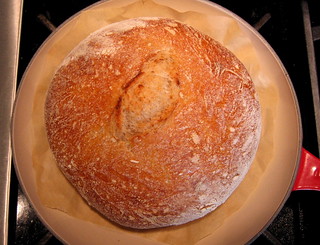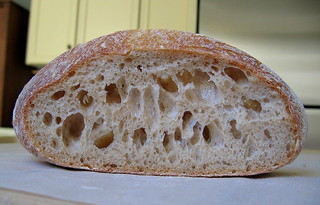Ken Forkish's method of proofing loaves seam side down in the banneton and then baking them seam side up is a nice trick for a lame/slashing/scoring challenged baker like me. Does this seam up baking method produce fissures in every type of bread?
My first attempt at a seam up bake hardly made a fissure. Am I doing something that prevented more fissures? I used Weekend Bakery's Tartine style recipe (which is 70% hydration). I shape retarded in the fridge for 18 hours.
TIA,
Mary


it might not work, also good to use a bit of flour to keep the seam from closing up. A light dusting of rice flour mixed with your flour (banneton flour) or rye flour on the dough before bringing up the sides and turning the loaf seam down into the banneton might help.
Mini - If I understand you correctly a light dusting of flour before bringing up the sides will keep the seams less sealed and then I might have a better chance of getting those lovely organic fissures I want since the seams can 'burst open' in the oven. I guess that makes sense.
It is very common in high rye breads as well, I know them as "Crusty" Loaves.
Hey emkay,
First the crumb in your loaf is magnificent.... I got hole envy!
Now, what do you mean by "fissures"? Did you "slash" the above loaf? Are you speaking of the "ears" you get from slashing the dough? (see photo below) Just baking with the seam up in most cases will not produce "ears".
I proof all my loafs seam side down and the bake seam side up after conventional slashing with a Lame. And the results is pictured below in one of my sourdough batards.
I think the "seam side-down / seam side-up" is to assist in the development of the CO2 gas formation throughout the crumb...... (?)
Your picture is truly a great looking round...... next one you make do all of the same, but hold your lame about 30ª to the surface and make a "one-motion" slash 1/4" into the surface of the dough most of the way across the top (in the direction of your seam. Then bake the same. You should get the oven puff which allows the slashed area to "pop".
I should add that my wife always likes the looks of the round you made over what I do, which she calls "pretty" loafs...... But she fusses that the "ears" make it harder to slice for sandwiches........ (a boy just can't win...)
Keep us posted........
BetsyMePoocho
BetsyMePoocho - Thanks for the compliment. I was pretty happy with this loaf considering it's only the third time I have ever made bread with a starter.
By fissures I didn't mean the "ears" that we get from slashing with a razor or lame. I didn't slash this loaf at all. In Forkish's FWSY he suggests that we don't slash the loaves. Instead the seam will naturally open up and create "fissures" on top as the loaf expands in the oven. The result should be organic looking splits on top of the loaf. I was trying to get that organic look for this loaf, but my seams hardly opened up.
I never really thought about it, but I guess the ears can be hard to slice. IMHO, the part just under the ears where the loaf has opened up is the best part of the loaf. So for me, the more ears the better!
This is one excample of a bread I posted a while ago:
I have to admit, before I had my baking stone, it didn't work very well either. The next trick: steam. The (the!!!) trick: Doing a bad job in closing the seam in the first place ;)
adri - LOL. I guess I did too good of a job closing the seams! :)
Westphalian Rye - one of the great rye breads of all time - one perfect for proofing seam side down. Happy baking.
Nice looking loaf.
The fissures without slashing technique, as mentioned in some of the other posts, was suggested by Ken Forkish who wrote a book called "Flour Water Salt Yeast." The idea is that the loaf can be shaped so that the "part folded in" (the seam) doesn't fuse with the remaining dough, and then will burst out during the oven spring.
The method you describe of proofing seam down and baking seam up [i][b]with[/b][/i] a score is different than what is normally recommended. I wouldn't call it "wrong" because I'm not convinced there is a wrong way to make bread ... and ... your loaf looks great (the proof is in the pudding!).
The typical recommendation is to proof the loaf seam side up and then bake seam side down. The score is on the side opposite the seam.
I can personally attest to the fact that the score in and of itself is not what results in an "ear" or "good oven spring." You need good gluten tension on the outer surface of the loaf, good gluten development *in* the loaf, proper proofing, AND the score. The oven conditions also come into play ... good heat, baking stone, and steam.
You must have all of the elements in place, because your loaf looks good!
Regards-
Dave
dosco,
Thank you for your good comments..... Yes, I'm also not convinced that there is one "absolute" method when it comes to baking.
I've been climbing the "bread learning curve" since 1996. I've studied and read that professional bakers swear by either method.... "up or down".... guess it is just a personal thing.
Your are very correct that a well formed loaf is the result of proper dough development.... i.e. hydration, gluten development, proofing times, surface tensioning, to mention just a few.
The "elements" to me are just the basic "A,B,C's" to good bread making..... what seems to be so very elusive in the beginning and even now, is to learn the "feel" of properly formed dough. I think that is what is wonderful and mysterious about the entire process... or actually "art".
Reading your comments it is obvious that you share in this passion of seeking the "perfect loaf".......
BetsyMePoocho
Mary:
Nice looking loaf and crumb. The development of an ear and grigne has to do with the overall gluten development, proper gluten tension on the outer surface of the loaf, proofing, score (or lack of if using the Forkish method), and baking methods/conditions.
In order to develop gluten, what sort of flour are you using? Do you autolyse? I assume you S&F instead of traditional kneading or machine kneading...? What process do you use for preshaping to develop surface tension? Final shaping of the loaf?
I assume you bake at high temperature with a stone and steam?
Regards-
Dave
Dave - I had a feeling that proper gluten development might play a part in my lack of fissures. I used a whole wheat starter, and 20:80 whole wheat:AP for the dough. I mixed by hand and I did autolyse. S and F every 30 min for 3 hours. I did not pre-shape and bench rest because the Weekend Bakery version did not call for one. In hindsight I think I should have. I shaped using a brotform and retarded in the fridge overnight. I baked using a preheated combo cooker. No baking stone.
edited to add: My starter is young. Only 9 days old but it's rising and falling predictably. Not sure if that is relevant.
proofing seam side down and balking seam side up to let the bread crack and bloom where it wants has been around for a long time before Ken Forkish came on the scene. Many breads from the old world have been baked that way for about forever. New World bakers are late to the bread baking techniques used by others for hundreds of years or even centuries :-) Still, it makes for a great looking loaf and the basis of many fine breads found around the world.
The first time ai saw it was David Snyder's fantastic Italian inspired http://www.thefreshloaf.com/node/32512/pugliese-capriccioso-take-3 where he had done some reading on breads from the Puglia region - probably while he was learning Italian :-)
i've wondered who the first baker was that said - 'Opps! Put that one in the basket upside down - oh well - let's see what happens.'
Dab- Yup, I agree that nothing"new" in bread baking is truly new since bread has been around forever. :) Thanks for the link to David S's post. I will take a look.
emkay,
You are so very correct.... only stuff I can see as "new" is strains of yeast, equipment, and knowledge/understanding of the what is actually going on (chemistry).....
Hey,,, I once read that a very long time ago one man and one loaf fed thousands of people....... Now that's baking! Kinda humbles us,,, huh?
Your "starter" is kick'n some dough butt to be as young as it is...... Good stuff!!
BetsyMePoocho
BetsyMePoocho- I was suprised that my starter took off so quickly. In fact, this loaf was a test to see if the starter was ready for prime time.
can also make a Chacon where you put knotted rolls, balls, braids, ropes, twisted ropes of different kinds and in combination in the bottom of the basket to create your own design and control to some degree where the cracks happen like here
http://www.thefreshloaf.com/node/28905/40-whole-multigrain-sd-and-yw-altamura-style-chacon
We love to make all kinds of them to get various cracked effects like this one You can search Chacon on this site and see all the various designs we have used for the past year and half - just too much fun,.
Dab- It looks so cool. I just did a search for chacon and there are tons of posts. I'm looking forward to reading them.